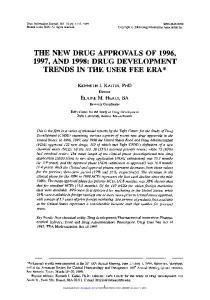Quantitative Analysis of the Role of Patents and Drug Approvals in Drug Lifecycle Management in Japan
- PDF / 1,206,585 Bytes
- 8 Pages / 595.276 x 790.866 pts Page_size
- 97 Downloads / 287 Views
ORIGINAL RESEARCH ARTICLE
Quantitative Analysis of the Role of Patents and Drug Approvals in Drug Lifecycle Management in Japan Takayuki Yamanaka1 • Shingo Kano1
Ó Springer International Publishing Switzerland 2016
Abstract Background Drug lifecycle management (LCM) contributes to the maximization of drug discovery investment returns. After obtaining drug approval for a new molecular entity (NME), additional approvals for improved products, including new indications and formulations of the molecular entity, can be obtained to allow extension of product marketability. A robust barrier to market entry is generated through drug patents. Furthermore, through the patent term extension (PTE) system, barriers to entry can be reinforced by extending patent terms that normally expire 20 years after filing. Objective The purpose of this research was to provide an overall view of drug LCM trends in the Japanese market from the perspective of drug approvals and patent protections between 2002 and 2013. Methods We identified all 1016 new approvals (such as NMEs, new indications, new formulations, new doses, and combination drugs) made by the Japanese Pharmaceuticals and Medical Devices Agency between 2002 and 2013. We obtained information on the corresponding applications for PTEs (APTEs) and PTEs for these approved drugs from the National Center for Industrial Property Information and Training, and created a drug approval–PTE database by combining these data. To analyze drug LCM in Japan over
& Takayuki Yamanaka [email protected] 1
Innovation Policy Research Unit, Department of Computational Biology and Medical Sciences, Graduate School of Frontier Sciences, The University of Tokyo, 5-1-5 Kashiwanoha, Kashiwa-shi, Chiba 277-8561, Japan
time from the perspective of drug approvals and PTEs, we focused on the number of new approvals acquired each year, the number of PTEs per drug approval, and the number of APTEs per drug approval. Additionally, we analyzed the breakdown of APTEs per approval based on international patent classifications. Results The number of new drug approvals and APTEs increased during the period from 2002 to 2013. The increase in approvals for new indications was the main factor for the increase in the total number of new approvals, indicating that pharmaceutical companies are focusing on increasing drug value by launching improved products, mainly drugs with new indications. A wide variety of patents, including substance patents, use patents, and formulation patents, have come to be a major component of the APTEs based on approvals for new indications, new formulations, and combination drugs. This phenomenon led to increased APTEs per approval. PTEs also increased during the study period, but a lag in the application process at the Japan Patent Office is reflected in a decrease in PTEs for 2012–2013. These PTEs were likely still under review when the study data were collected. Conclusions Japan has seen a change in LCM over time from a relatively small number of new approvals and a few
Data Loading...











